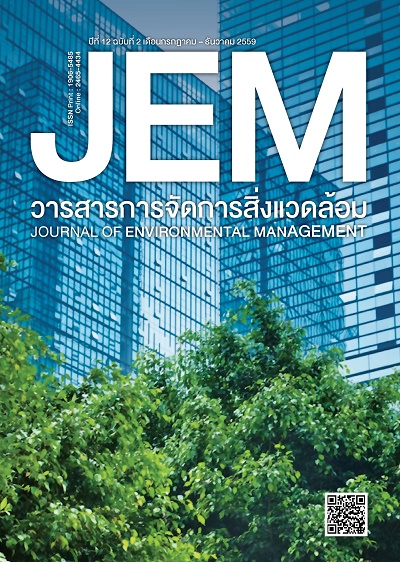การสื่อสารเพื่อสร้างการมีส่วนร่วมในโครงการ 4ม. ขอคืนพื้นที่เขาใหญ่ของกลุ่มเยาวชนต้นกล้าจังหวัดนครนายก PARTICIPATORY COMMUNICATION IN THE 4DS—A CAMPAIGN BY TONKLA NAKHONNAYOK YOUTH CLUB—AT KHAO YAI NATIONAL PARK
บทคัดย่อ
การวิจัยนี้เป็นการวิจัยเชิงคุณภาพ มีวัตถุประสงค์เพื่อศึกษาการสื่อสารเพื่อสร้างการมีส่วนร่วมของกลุ่มเยาวชนต้นกล้าจังหวัดนครนายก รูปแบบและลักษณะการมีส่วนร่วมของเยาวชนและปัจจัยที่เกี่ยวข้องกับการสื่อสารเพื่อสร้างการมีส่วนร่วมในโครงการ 4ม. ขอคืนพื้นที่เขาใหญ่ ผลวิจัยพบว่า กลุ่มเยาวชนต้นกล้าจังหวัดนครนายกมีส่วนร่วมทุกมิติด้านการสื่อสาร คือ 1) เยาวชนร่วมติดตามและรับข่าวสารผลกระทบด้านการท่องเที่ยวเพื่อมาประยุกต์ใช้ในกิจกรรม 2) เยาวชนร่วมเป็นผู้ผลิตเนื้อหาผลิตสื่อต่างๆ และเป็นผู้แสดง 3) เยาวชนร่วมกำหนดนโยบายด้านการสื่อสารอย่างอิสระและลักษณะการมีส่วนร่วมของเยาวชนตามหลักบันได 8 ขั้น พบว่า เยาวชนมีส่วนร่วมในขั้นที่ 6 - 8 คือ กลุ่มเยาวชนต้นกล้าจังหวัดนครนายกกับกลุ่มผู้ใหญ่ที่เกี่ยวข้องในโครงการ 4ม. ร่วมกันดำเนินงาน ร่วมปรึกษาหารือ ร่วมคิด ร่วมตัดสินใจจนเยาวชนสามารถริเริ่มปฏิบัติกิจกรรมจากความคิดของเยาวชนได้เท่าเทียมผู้ใหญ่ ซึ่งปฏิกิริยาตอบรับจากการสื่อสารพบว่า การสื่อสารของเยาวชนได้รับความสนใจจากนักท่องเที่ยวสะท้อนให้เห็นว่าเยาวชน คือ ตัวแทนประชาชนกลุ่มใหม่ที่เป็นพลังสำคัญในการดูแลทรัพยากรธรรมชาติ สัตว์ป่าและสิ่งแวดล้อมในอนาคต และจะเป็นพลังผลักดันโครงการ 4ม. ขอคืนพื้นที่เขาใหญ่ขึ้นสู่นโยบายระดับประเทศ เพื่อพัฒนาการท่องเที่ยวอุทยานแห่งชาติในประเทศไทยให้ยั่งยืนต่อไปได้
This qualitative research aimed to analyze the 4Ds—a participatory campaign by the TonKla Nakhonnayok Youth Club to raise awareness of tourists’ behavior when visiting Khao Yai National Park. The 4Ds are: “Don’t Feed the Animals”, “Don’t Litter”, “Don’t Drive Fast”, and “Don’t Make Loud Noise”. The results of the research identified that the youths participated in all dimensions of communication, including acquisition of information regarding the impacts of tourism from various sources. These data were then used to create the activities. Another dimension was the production of the campaign, content creation, media selection, and production equipment before practicing and performing the activities. Finally, the youths participated in formulating a free communication policy. The participation characteristics of the campaign involved both the Tonkla Nakhonnayok Youth Club and the adult group, which made joint decisions concerning the operations and working together to solve problems. Consequently, the youths were able perform activities at a high standard. Feedback was included from the tourists, who were interested in the campaign and reinforced the youth’s position as ambassadors of the national park and future managers of nature and wildlife. Going forward, they potentially have the opportunity to environmentally manage the National Park through the implementation of the 4Ds and campaign for it to become a national policy, thus developing sustainable tourism in this national park.
เอกสารอ้างอิง
Connors, J., Zermatten, J., & Panayotidis, A. (Eds.) (2007). 18 Candles: The Conventions on the Rights of the Child Reaches Majority. Sion: Institut International des droits de l' enfant.
Fletcher, A. (2013). The Freechild Project Youth-Driven Programming Guide. Olympia, WA: CommonAction Consulting.
Hart, A. R. (1992). Children’s Participation from Tokenism to Citizenship. Innocenti Essays No. 4., United Nations Children’s Fund.
IUCN (1994). Guidelines for Protected Area Management Categories. Gland; Cambridge: IUCN.
Kaewthep, K. (2006). Communication for Beautiful World: Lessons from Communication for Community Environmental Management [In Thai: สื่อสารเพื่อโลกสวย: บทเรียนจากการสื่อสารเพื่อการจัดการสิ่งแวดล้อมชุมชน]. Bangkok: Seven Printing Group.
Khongchum, C. (2011). Behavior of pig-tailed macaque and tourist, and the effects of Stop-feeding Macaques Campaign on Thanarat Road, Khao Yai National Park. Bachelor’s project (Conservation Biology), Mahidol University.
Lingela, M. B. (2006). Participatory of Communication in radio broadcasting in Zambia: The case of the Mazabuka Community Radio Station. Master’s thesis (Communication for Development), University of Zambia, Lusaka.
Muganda, M. (2009). Community Involvement and Participation in Tourism Development in Tanzania: A case study of local communities in Barabarani Village, Mto wa Mbu, Arusha-Tanzania. Master’s thesis, Victoria University of Wellington, New Zealand.
Naipongsri, S. (2011). Valuing Protected Area by Users: A Case Study of Khao Yai National Park [In Thai]. Master’s Thesis (Parks, Recreation, and Tourism), Department of Conservation, Kasetsart University.
National Parks Research Center. (2014). Visitor Statistics [In Thai]. Retrieved January 10, 2015, from http://park.dnp.go.th/visitor/indexresearch.php
Nonthihathai, A. (2008). Participatory communication of the youth for development of “TK Teen” TV program. [In Thai]. Master’s Thesis, (Department of Public Relations), Faculty of Communication Arts), Chulalongkorn University.
Office of National Parks, Wildlife and Plant Conservation. (2012). Situation of natural resource problem and visitor statistics, Khao Yai National Park in 2012 [In Thai]. Retrieved September 9, 2013, from http://park.dnp.go.th/visitor
Padungchewit, J. (2012). Participatory Communication for Balance and Sustainability [In Thai]. Paper presented at the “15 Years from Economic Crisis: Sufficiency Economy and Thailand’s Sustainability” conference, Center of the Study of Sufficiency Economy, National Institute of Development Administration. Retrieved September 9, 2013, from http://cse.nida.ac.th/main/images/ParticipatoryCommunicationForBalanceAndSustainability.pdf
Phumsathan, S. (2011). Environmental Impacts of Tourism in Khao Yai National Park, Thailand. Doctoral thesis (Recreation, Park and Tourism Sciences), Texas A&M University.
Servaes, J., Jacobson, T. L. & White, S. A. (Eds.) (1996). Participatory Communication for Social Change. Thousand Oaks; London: Sage Publications.
Sittiphan, R. (2009). Communication and Improving Community Participation and Management on Erosion: Case Study of Baan Khun Samutchine, Samutprakarn [In Thai]. Master’s thesis, (Mass Communication), Faculty of Journalism and Mass Communication, Thammasat University.
Songkasant, P. (2008). The effectiveness of communication in Palmyra conservation in Phetchaburi Province [In Thai]. Master’s Thesis, (Department of Public Relations), Faculty of Communication Arts), Chulalongkorn University.
UNICEF Thailand (2011). Situational Analysis of Women and Children 2010. Bangkok: United Nations Children’s Fund.
Uthayarat, S. (2012). Communication and community people’s participation in managing ecotourism resource, case study: Tam Kang Kao Wat Khao Chong Pran, Rachaburi province [In Thai]. Master’s Thesis, Faculty of Communication Arts, Dhurakij Pundit University.



